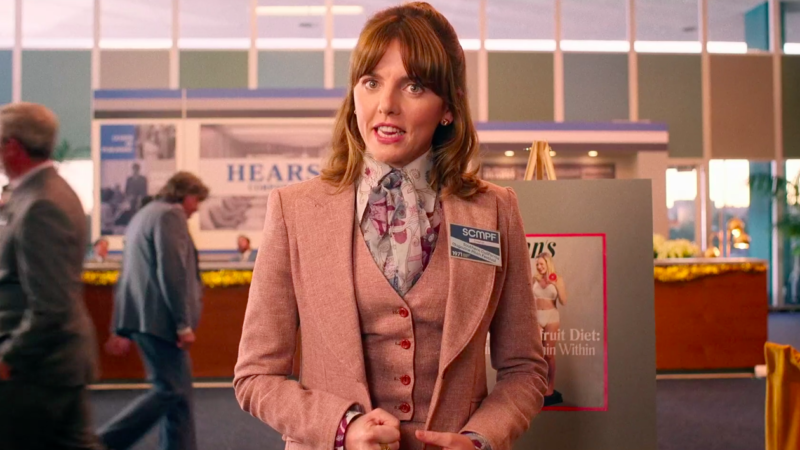
Minx. Available now on HBO Max.
There's a scene in the second episode of HBO Max's raunchy, charming, and altogether hilarious new comedy Minx that perfectly sums up what the show is all about. Fiery young women's libber (as they were known in 1971, the year in which Minx is set) Joyce is complaining to her matronly older sister Shelly that the male publisher of her new feminist magazine is selling ads to dildo retailers. "What woman wants a sex toy?" Joyce demands, rhetorically though furiously. "I don't know any woman who uses them." Shelly fixes her with a steady gaze and quietly replies: "Yes you do."
Minx, though it's too breezily funny and sweetly affectionate toward its characters to truly be fiercely ideological, is indeed a witty treatise on liberating early feminism from its frigid Victorian conviction that gender equality and sexual desire are incompatible—that, indeed, freeing women from the frumpy societal compulsion to pretend they aren't interested in sex may be the most fundamental liberation of all.
Minx stars British actress Ophelia Lovibond (best known to American TV audiences for a season playing a Sherlock Holmes protege on the CBS series Elementary) as Joyce Prigger, a prim but passionate young Vassar grad who spends her nights dreaming about creating a glossy feminist journal that she wants to call The Matriarch Awakes. Her days, unfortunately, are spent selling subscriptions by phone for the distinctly unfeminist magazine Teen Queen. Publishers, mostly white men, have no idea what she's talking about at a time when even the milder-tempered magazine Ms. was still a year in the future.
But then, while at a publishing seminar, she has a chance encounter with a semi-sleazeball named Doug Renetti (Jake Johnson, New Girl), whose stable of magazines includes such titles as Chesty Chicanas and Lusty Lesbos and whose interest in branching out in less exuberantly fleshy directions does not impress her. "I'm looking for a different kind of publisher," she informs him.
"What kind is that?" the puzzled Doug inquires.
"The kind who doesn't fetishize lactating mothers," Joyce snaps
Nonetheless, Doug's more redeeming qualities—chiefly, the cash to cover startup costs—gets Joyce onboard, at least until she hears his take-it-or-leave-it demand: Her written content can stand as she imagines it, but each issue must have a full-frontal male centerfold. Her scandalized refusal is met with her own rhetoric, stood on its head. Joyce claims her idea is about "making shit fair and equal for the chicks," Doug notes. "How is it fair and equal that a guy has 12 places to see titties, but a gal has no place to go see a dong?"
"Gals do not want to see dongs," Joyce insists. But when Cosmopolitan's one-shot centerfold of a bare, if strategically obscured, Burt Reynolds sells half a million copies, she reluctantly changes her mind.
What follows is a wonderfully demented editorial tug-of-war between the starchy Joyce and a production staff that doesn't entirely understand her theories on "the ideology of erections" ("Should they be approachable…draped gently on their sides?") but knows from experience that the point of centerfolds is pure prurience. When Joyce wants to screen potential models by reading them selections from Anais Nin and reacts with horror to the idea of them showing their stuff, a curious editor jokingly asks if she's ever seen a penis. "I've seen two…and a half…in very dim lighting," Joyce whispers back.
What makes Minx so delightful is that this mini culture war is accomplished with almost none of the spitefulness and contempt of the real one. Both Joyce and Doug say some clueless things that could give offense but don't because Lovibond and Johnson skillfully portray their characters as people of goodwill groping their way through unfamiliar territory. (In Joyce's case, that includes some unexamined attitudes about race and class, as when she asks Doug's chief adviser to get her some tea. (The chilly response: "I'm not the secretary. I'm just black.") That extends on down to even the minor characters, photographers, and paste-up artists, who aren't at all sure where Joyce is headed but are happy to ride along for the sheer adventure of it.
It should also be noted that Minx is almost certainly the most penis-friendly show in television history, though HBO's teen-boinkfest Euphoria is providing some stiff (heh heh) competition. And yes, there are some anachronistic missteps in writer-creator Ellen Rapoport's (Wannabe: A Hollywood Experiment) otherwise sure-footed screenplays. But Rapoport is so sharply funny that you can't even get mad at her mistakes, as when she has Joyce gloriously singing along to Helen Reddy's feminist anthem I Am Woman on a car radio a full year before the record was actually released. Still singing as she gets out of the car, Joyce belts out the next-to-final lines—"I am strong, I am invincible!"—as she enters the magazine office for the first time, where she sees the newsroom is an anthill of nude models and sexual paraphernalia. And her voice drops to a whisper: "I'm in Gomorrah…"
The post <i>Minx</i> Is a Witty Treatise on Early Feminism appeared first on Reason.com.







